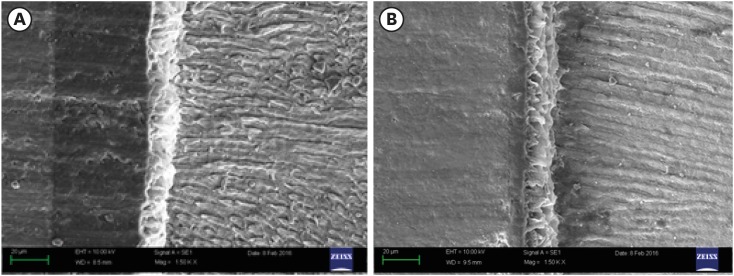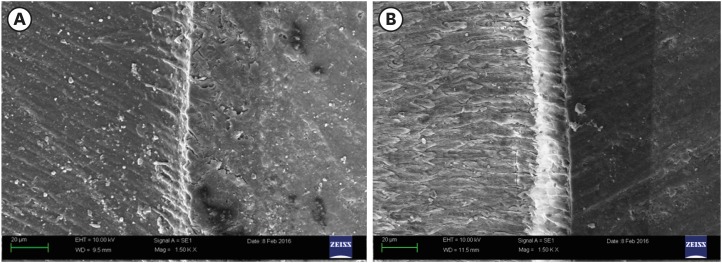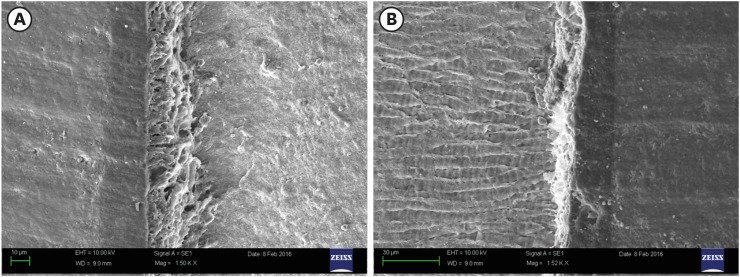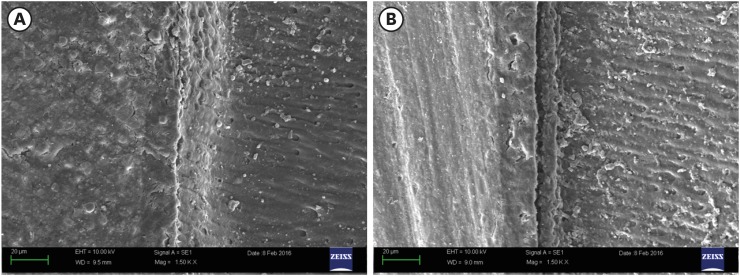1. Hashimoto M, Ohno H, Kaga M, Endo K, Sano H, Oguchi H.
In vivo degradation of resin-dentin bonds in humans over 1 to 3 years. J Dent Res. 2000; 79:1385–1391. PMID:
10890717.
2. Yang B, Adelung R, Ludwig K, Bössmann K, Pashley DH, Kern M. Effect of structural change of collagen fibrils on the durability of dentin bonding. Biomaterials. 2005; 26:5021–5031. PMID:
15769538.

3. Pashley DH, Tay FR, Yiu C, Hashimoto M, Breschi L, Carvalho RM, Ito S. Collagen degradation by host-derived enzymes during aging. J Dent Res. 2004; 83:216–221. PMID:
14981122.

4. Pashley DH, Tay FR, Breschi L, Tjäderhane L, Carvalho RM, Carrilho M, Tezvergil-Mutluay A. State of the art etch-and-rinse adhesives. Dent Mater. 2011; 27:1–16. PMID:
21112620.

5. Bedran-Russo AK, Pauli GF, Chen SN, McAlpine J, Castellan CS, Phansalkar RS, Aguiar TR, Vidal CM, Napotilano JG, Nam JW, Leme AA. Dentin biomodification: strategies, renewable resources and clinical applications. Dent Mater. 2014; 30:62–76. PMID:
24309436.

6. Monteiro TM, Basting RT, Turssi CP, França FM, Amaral FL. Influence of natural and synthetic metalloproteinase inhibitors on bonding durability of an etch-and-rinse adhesive to dentin. Int J Adhes Adhes. 2013; 47:83–88.

7. Castellan CS, Bedran-Russo AK, Antunes A, Pereira PN. Effect of dentin biomodification using naturally derived collagen cross-linkers: one-year bond strength study. Int J Dent. 2013; 2013:918010. PMID:
24069032.

8. Erhardt MC, Osorio R, Viseras C, Toledano M. Adjunctive use of an anti-oxidant agent to improve resistance of hybrid layers to degradation. J Dent. 2011; 39:80–87. PMID:
21035517.

9. Khamverdi Z, Rezaei-Soufi L, Rostamzadeh T. The effect of epigallocatechin gallate on the dentin bond durability of two self-etch adhesives. J Dent (Shiraz). 2015; 16:68–74.
10. Hiraishi N, Sono R, Sofiqul I, Yiu C, Nakamura H, Otsuki M, Takatsuka T, Tagami J.
In vitro evaluation of plant-derived agents to preserve dentin collagen. Dent Mater. 2013; 29:1048–1054. PMID:
23942145.
11. Sorsa T, Tjäderhane L, Konttinen YT, Lauhio A, Salo T, Lee HM, Golub LM, Brown DL, Mäntylä P. Matrix metalloproteinases: contribution to pathogenesis, diagnosis and treatment of periodontal inflammation. Ann Med. 2006; 38:306–321. PMID:
16938801.

12. Hass V, de Paula AM, Parreiras S, Gutiérrez MF, Luque-Martinez I, de Paris Matos T, Bandeca MC, Loguercio AD, Yao X, Wang Y, Reis A. Degradation of dentin-bonded interfaces treated with collagen cross-linking agents in a cariogenic oral environment: an
in situ study. J Dent. 2016; 49:60–67. PMID:
27106766.
13. Roomi MW, Ivanov V, Kalinovsky T, Niedzwiecki A, Rath M. Inhibition of matrix metalloproteinase-2 secretion and invasion by human ovarian cancer cell line SK-OV-3 with lysine, proline, arginine, ascorbic acid and green tea extract. J Obstet Gynaecol Res. 2006; 32:148–154. PMID:
16594917.

14. Gotti VB, Feitosa VP, Sauro S, Correr-Sobrinho L, Leal FB, Stansbury JW, Correr AB. Effect of antioxidants on the dentin interface bond stability of adhesives exposed to hydrolytic degradation. J Adhes Dent. 2015; 17:35–44. PMID:
25625137.
15. Khamverdi Z, Rezaei-Soufi L, Kasraei S, Ronasi N, Rostami S. Effect of Epigallocatechin Gallate on shear bond strength of composite resin to bleached enamel: an
in vitro study. Restor Dent Endod. 2013; 38:241–247. PMID:
24303360.
16. Meharry MR, Moazzami SM, Li Y. Comparison of enamel and dentin shear bond strengths of current dental bonding adhesives from three bond generations. Oper Dent. 2013; 38:E237–E245. PMID:
23802638.

17. Scheffel DL, Delgado CC, Soares DG, Basso FG, de Souza Costa CA, Pashley DH, Hebling J. Increased durability of resin-dentin bonds following cross-linking treatment. Oper Dent. 2015; 40:533–539. PMID:
25764044.

18. Mobarak EH. Effect of chlorhexidine pretreatment on bond strength durability of caries-affected dentin over 2-year aging in artificial saliva and under simulated intrapulpal pressure. Oper Dent. 2011; 36:649–660. PMID:
21864128.

19. Montagner AF, Sarkis-Onofre R, Pereira-Cenci T, Cenci MS. MMP inhibitors on dentin stability: a systematic review and meta-analysis. J Dent Res. 2014; 93:733–743. PMID:
24935066.
20. Tezvergil-Mutluay A, Agee KA, Hoshika T, Carrilho M, Breschi L, Tjäderhane L, Nishitani Y, Carvalho RM, Looney S, Tay FR, Pashley DH. The requirement of zinc and calcium ions for functional MMP activity in demineralized dentin matrices. Dent Mater. 2010; 26:1059–1067. PMID:
20688380.

21. Scheffel DL, Hebling J, Agee KA, De Souza Costa CA, Pashley DH. Collagen degradation and MMP activity in dentin biomodified by cross-linkers. Dent Mater. 2014; 30(Supplement 1):e158.

22. Scheffel DL, Hebling J, Scheffel RH, Agee KA, Cadenaro M, Turco G, Breschi L, Mazzoni A, Costa CA, Pashley DH. Stabilization of dentin matrix after cross-linking treatments,
in vitro. Dent Mater. 2014; 30:227–233. PMID:
24332989.
23. Seseogullari-Dirihan R, Tjaderhane L, Breschi L, Vallittu P, Pashley DH, Tezvergil-Mutluay A. Effect of pretreatment pH on dentin protease inactivation by carbodiimide. Dent Mater. 2012; 28(Supplement 1):e64.

24. Angeloni V, Mazzoni A, Frassetto A, Cadenaro M, Falconi M, Manzoli L, Pashley DH, Breschi L. EDC stabilize the adhesive interface over time. Dent Mater. 2013; 29(Supplement 1):e65–e66.

25. Cadenaro M, Fontanive L, Navarra CO, Gobbi P, Mazzoni A, Di Lenarda R, Tay FR, Pashley DH, Breschi L. Effect of carboidiimide on thermal denaturation temperature of dentin collagen. Dent Mater. 2016; 32:492–498. PMID:
26764172.

26. Tezvergil-Mutluay A, Mutluay MM, Agee KA, Seseogullari-Dirihan R, Hoshika T, Cadenaro M, Breschi L, Vallittu P, Tay FR, Pashley DH. Carbodiimide cross-linking inactivates soluble and matrix-bound MMPs,
in vitro. J Dent Res. 2012; 91:192–196. PMID:
22058118.
27. Scheffel DL, Hebling J, Scheffel RH, Agee K, Turco G, de Souza Costa CA, Pashley D. Inactivation of matrix-bound matrix metalloproteinases by cross-linking agents in acid-etched dentin. Oper Dent. 2014; 39:152–158. PMID:
23786610.

28. Perumal S, Antipova O, Orgel JP. Collagen fibril architecture, domain organization, and triple-helical conformation govern its proteolysis. Proc Natl Acad Sci USA. 2008; 105:2824–2829. PMID:
18287018.

29. da Fonseca BM, Pleffken PR, Balducci I, Pucci CR, Tay FR, de Araujo MA. New trends in dentin bonding: treatment with Chlorhexidine, Hyaluronic acid, vitamin C and green tea. Braz Dent Sci. 2013; 16:56–62.
30. Santiago SL, Osorio R, Neri JR, Carvalho RM, Toledano M. Effect of the flavonoid epigallocatechin-3-gallate on resin-dentin bond strength. J Adhes Dent. 2013; 15:535–540. PMID:
23560257.
31. Zheng P, Zaruba M, Attin T, Wiegand A. Effect of different matrix metalloproteinase inhibitors on microtensile bond strength of an etch-and-rinse and a self-etching adhesive to dentin. Oper Dent. 2015; 40:80–86. PMID:
24815915.

32. Carvalho C, Fernandes FP, Freitas VP, França FM, Basting RT, Turssi CP, Amaral FL. Effect of green tea extract on bonding durability of an etch-and-rinse adhesive system to caries-affected dentin. J Appl Oral Sci. 2016; 24:211–217. PMID:
27383701.

33. Stanislawczuk R, Costa JA, Polli LG, Reis A, Loguercio AD. Effect of tetracycline on the bond performance of etch-and-rinse adhesives to dentin. Braz Oral Res. 2011; 25:459–465. PMID:
22031061.

34. Li H, Li T, Li X, Zhang Z, Li P, Li Z. Morphological effects of MMPs inhibitors on the dentin bonding. Int J Clin Exp Med. 2015; 8:10793–10803. PMID:
26379873.
35. Pinnel SR, Murad S, Darr D. Induction of collagen synthesis by ascorbic acid. A possible mechanism. Arch Dermatol. 1987; 123:1684–1686. PMID:
2825607.









 PDF
PDF ePub
ePub Citation
Citation Print
Print






 XML Download
XML Download